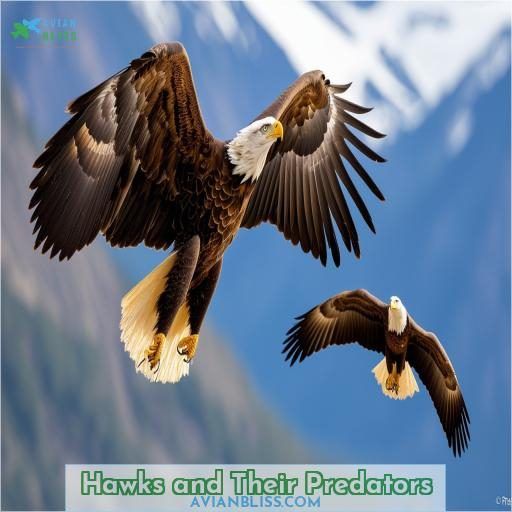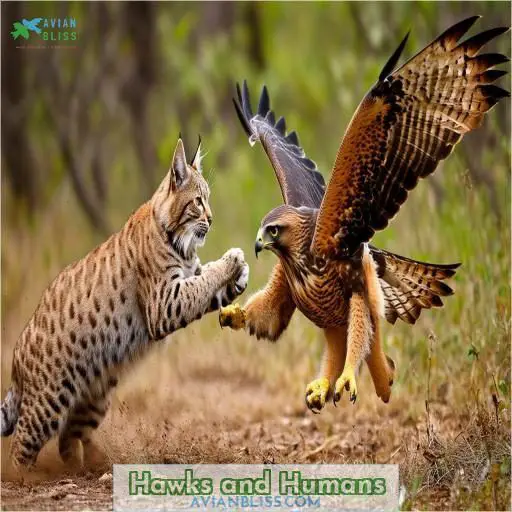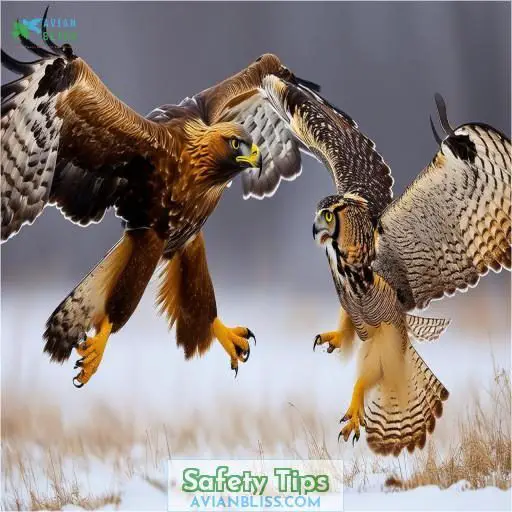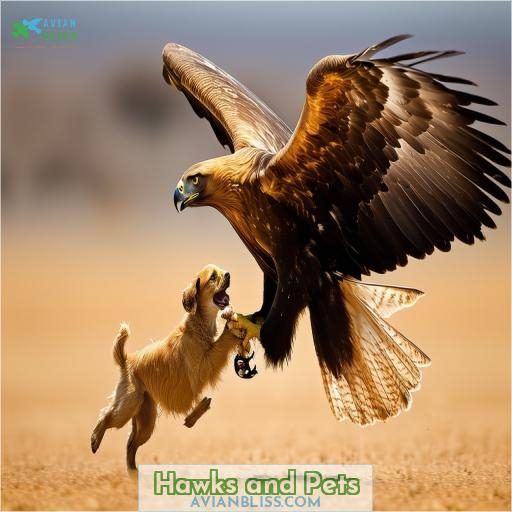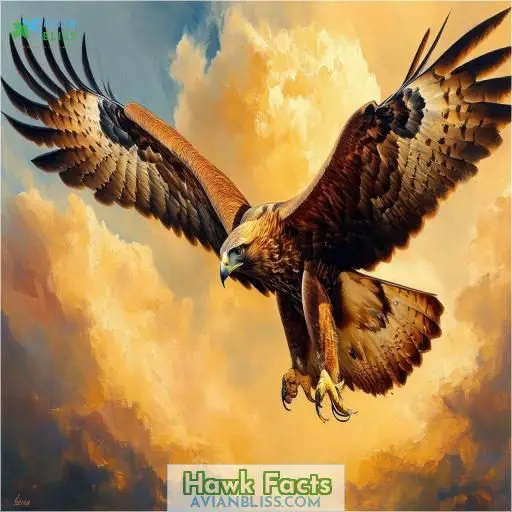This site is supported by our readers. We may earn a commission, at no cost to you, if you purchase through links.
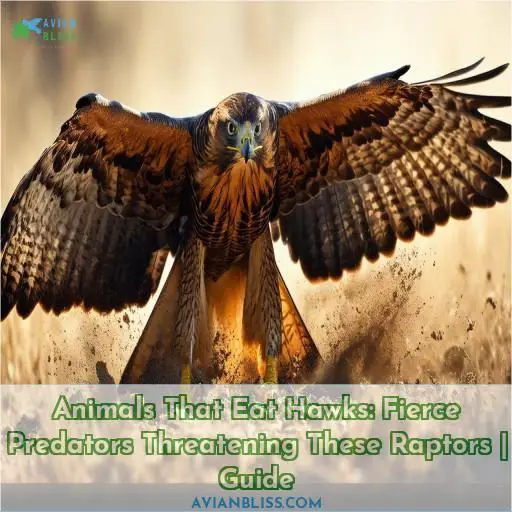 As a keen observer of nature, you’re well aware that hawks, though formidable predators, aren’t exempt from the food chain’s harsh realities.
As a keen observer of nature, you’re well aware that hawks, though formidable predators, aren’t exempt from the food chain’s harsh realities.
Eagles, with their superior size and strength, don’t hesitate to ransack hawk nests or engage in midair duels.
Owls, masters of stealth, ambush unsuspecting hawks.
Felines, with their agility and sharp claws, can snatch hawks from the ground.
Canines like coyotes and foxes capitalize on any overlap in habitat.
Snakes, from humble rat snakes to massive pythons, prey on hawk eggs and nestlings.
Brace yourself, as understanding these predatory dynamics reveals nature’s intricate balancing act.
Table Of Contents
- Key Takeaways
- Hawks and Their Predators
- Hawks and Humans
- Safety Tips
- Hawks and Pets
- Hawk Facts
- Deterring Hawks
- Frequently Asked Questions (FAQs)
- What are the predators of the hawk?
- Do coyotes eat hawks?
- Where is a hawk in the food chain?
- What animals are hawks afraid of?
- Do hawks ever attack humans for food?
- Can pet dogs chase away large hawks?
- How effective are bird spikes against hawks?
- Do hawks prey on outdoor pet chickens?
- What attracts hawks to urban neighborhoods?
- Conclusion
Key Takeaways
- Even the mighty hawk isn’t immune to nature’s ruthless food chain. These raptors face a gauntlet of formidable predators, from soaring eagles that can outmuscle them in midair duels to stealthy felines patiently waiting to pounce on an unsuspecting bird.
- Birds of prey like owls are the real ninjas of the sky, ambushing hawks with their silent, deadly stealth. It’s like a real-life game of owl versus hawk played out in the treetops.
- While coyotes and foxes may seem like unlikely foes, these cunning canines can capitalize on any overlap in territory, wearing down fledgling hawks until they’re primed for the taking.
- Even slithering serpents get in on the action, with sneaky snakes like rat snakes and massive pythons raiding hawks’ nests for a protein-packed meal of eggs or nestlings. Talk about a feathery feast!
Hawks and Their Predators
As apex predators, hawks face threats from larger and more powerful birds of prey like eagles and owls.
As well as stealthy mammals such as felines, canines, and snakes that skillfully target their nests and hunt the raptors themselves.
To fully appreciate the perils hawks navigate, it is crucial to examine the formidable predators that pose a constant danger to these remarkable birds of prey.
Eagles
You face a formidable aerial adversary in eagles. These raptors:
- Detect and raid hawk nests
- Engage in midair duels
- Ransack catches from hawks
- Prey on eggs and nestlings
Owls
You’ll encounter formidable owl hunters like great horned owls and Eurasian eagle owls preying on hawks. They:
- Target young, fledgling hawks
- Attack adult hawks aggressively
- Consume hawk eggs unguarded
- Ambush unwary raptors stealthily
Felines
You’re a fierce feline predator, stealthily stalking hawks with:
- Sharp claws for snatching prey
- Powerful legs to pounce
- Keen eyesight for hunting
- Agility for ambushing birds
Raptors beware your catlike mastery!
Canines
Coyotes and foxes also prey on hawks, wearing down fledglings until they’re catchable. Red foxes even raid low-lying hawk nests for eggs and nestlings.
- Coyotes attack ground-dwelling hawks
- Foxes snatch nestlings from accessible nests
- Both capitalize on habitat overlap
Snakes
You’re also at risk from snakes that raid hawk nests for eggs and nestlings. Here are some key threats:
- Rat snakes climb to pilfer chicks
- Rattlesnakes ambush roosting adults
- Large pythons ingest nestlings whole
- Hawks’ sharp talons deter most snakes
Nest Predators
You’ll find many predators try raiding hawk nests, including:
- Common ravens
- Raccoons
- Weasels
- Other birds of prey
These cunning nest raiders employ clever tactics.
Prey of Hawks
Hawks are fierce predators themselves, hunting a variety of prey. Their diet consists of:
- Mice
- Small birds
- Snakes
- Rabbits and hares
Understanding hawks’ prey helps appreciate their ecological role.
Hawks and Humans
Hawks rarely pose a threat to humans, but you should remain cautious. While unlikely to carry off children, these raptors may defend their territory aggressively if they perceive you as a threat. Their exceptional eyesight allows them to:
- Detect potential competitors from afar
- Identify prey with pinpoint accuracy
- Swiftly launch aerial attacks
- Aggressively defend nesting sites
Respecting these powerful hunters’ space is wise. Admire their hunting prowess from a safe distance.
Safety Tips
While observing hawks, you’ll want to take precautions. First, supervise pets outdoors, especially smaller animals that could become prey. Second, use deterrents like:
- Reflective tape or mirrors to startle hawks
- Owl decoys to make them think predators are nearby
- Hanging pie pans or wind chimes to create sudden movements
These steps help guarantee your safety while appreciating these magnificent raptors. Respect their hunting habits, but take sensible measures to coexist peacefully.
Hawks and Pets
You likely don’t need to worry about hawks preying on adult pets. However, smaller pets under 5 lbs could be tempting targets. To keep furry friends safe:
- Supervise pets outdoors, especially in hawk territory.
- Use deterrents like reflective tape or owl decoys.
- Provide covered areas for pets to take shelter.
- Keep pets leashed when hiking or camping.
With some precautions, you can enjoy watching these magnificent hunters from a respectful distance while safeguarding your beloved companions.
Hawk Facts
As pet owners, you’ll want to appreciate hawks for their impressive traits.
Hawks are highly skilled predators, with razor-sharp eyesight up to 8 times better than humans.
They have specialized wings designed for silent, agile flight. They also have powerful talons for grasping prey.
Their role in controlling rodent populations is vital, but their diet also includes frogs, snakes, and small birds.
From soaring red-tails to stealthy Cooper’s hawks, these raptors display remarkable hunting abilities – a true demonstration of nature’s majesty.
Deterring Hawks
You can deter hawks by using scarecrows, owl decoys, and covered bird feeders. Roosters’ loud crows also help scare away these raptors. Consider these tips:
- Install shiny objects that sway in the wind to deter hawks
- Use netting or wire over pens to secure small pets
- Remove potential food sources like rodents and birds
- Plant bushes and trees for smaller birds to find cover
- Support hawk conservation efforts to maintain ecological balance
Frequently Asked Questions (FAQs)
What are the predators of the hawk?
Powerful birds like eagles, owls, and larger hawks are the primary predators that will fearlessly attack and prey upon hawks. With their razor-sharp talons and immense strength, these formidable aerial hunters relentlessly pursue and subdue hawks for their next meal.
Do coyotes eat hawks?
Yes, coyotes are opportunistic predators that can wear down and capture fledgling hawks or ambush unwary ground-dwelling species like northern harriers. Their persistence allows coyotes to successfully hunt these skilled avian hunters.
Where is a hawk in the food chain?
Though small, hawks occupy a pivotal role in the food chain as apex predators, skillfully hunting prey while dodging formidable foes themselves.
What animals are hawks afraid of?
As apex predators, hawks must be wary of larger raptors like eagles, great horned owls, and other formidable hunters that could overpower and take their eggs or young. Maintaining vigilance against these threats is essential for their survival.
Do hawks ever attack humans for food?
Nope, hawks see you as no threat. They swoop for small prey like rodents or birds, not burly humans. But keep pets inside – an unwatched pooch could tempt a hungry raptor.
Can pet dogs chase away large hawks?
Yes, releasing a well-trained, spirited dog can discourage hawks from lurking near your property. Dogs bark territorially, scaring off these formidable raptors. However, never risk confrontations – hawks have razor-sharp talons for self-defense.
How effective are bird spikes against hawks?
Bird spikes can deter hawks from roosting, but they’re not foolproof. Installing them at entry points, ledges, and favored perches denies hawks a comfy spot to stake their claim. However, determined hawks may still circle the area, so additional deterrents like reflective tape or owl decoys bolster your defenses.
Do hawks prey on outdoor pet chickens?
Yes, hawks are opportunistic predators that may prey on outdoor chickens, especially young or small ones. You can deter them by using covered runs, enclosed coops, and deterrents like reflective tape or fake owls.
What attracts hawks to urban neighborhoods?
You’ll often find hawks frequenting urban areas teeming with rodents, birds, and other small prey they relish. These raptors soar overhead, perching on trees or buildings to survey their surroundings and swoop in for the hunt.
Conclusion
As apex predators, hawks face threats from animals that eat hawks, including eagles, owls, felines, canines, and snakes. Over 30% of hawk nestlings don’t survive due to predation. Understanding these threats is essential for preserving the delicate balance in nature. By being mindful of hawk habitats and taking precautions, you can contribute to safeguarding these magnificent raptors.

